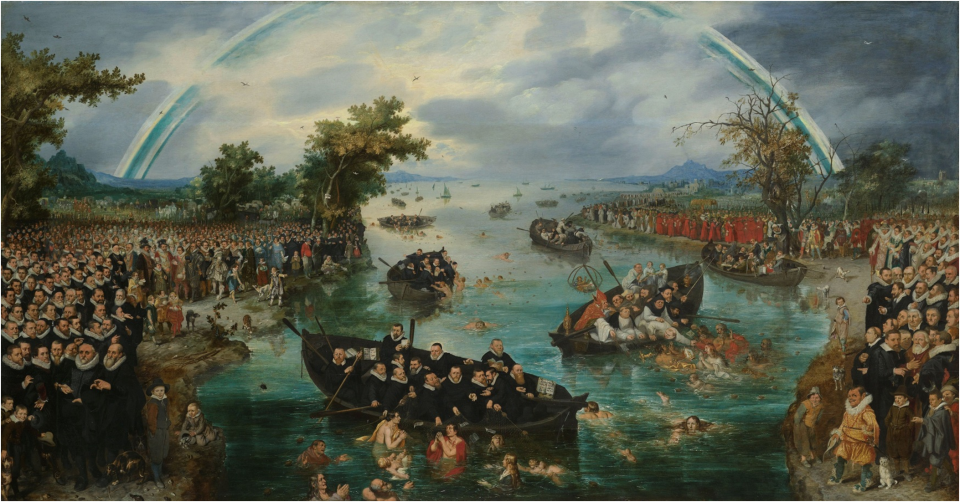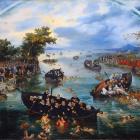
Adriaen Pietersz van de Venne, Fishing for Souls, 1614
Adriaen Pietersz van de Venne, Fishing for Souls, 1614
Oil painting by Adriaen Pietersz van de Venne. Click here to view Wikimedia source.
 This work is licensed under a Creative Commons Public Domain Mark 1.0 License.
This work is licensed under a Creative Commons Public Domain Mark 1.0 License.
Early modern interaction with water, be it through coastal flooding, stranded sea-life, or trial by ordeal, was one of the totemic means of decoding and countering divine power. Water was woven into the fabric of cultural life: it was an active agent in Eucharistic and baptismal rites; the dunking stool was a popular form of judicial punishment; when whales became beached, doomsday prophesies thrived. Human supremacy was built on the premise of a knowable world where regularity and (religious) reasoning formed the bedrock of a governable society. Water was a medium through which one could predict, and find predictable, the laws of the universe. In early modern Europe, the landscape became the machine upon which humanity could exert its domination; the exploitation of resources was (and, perhaps, still is) the ultimate goal for a species that was reordering the hierarchies of nature and culture. Land reclamation, early maritime exploration (and the corresponding growth in cartography), and the tumult of religious fervor (such as the 1566 Beeldenstorm or Iconoclastic Fury) that polarized Catholicism and Protestantism all contributed, at least in the Dutch Republic, to the emergence of a particular water imaginary. Movement was everywhere. Instability, flux, and motion, like the hydraulics and clockwork mechanics that gained such traction in the period, made meaningful injunctions not only in the landscape—with mills, polders, sluices, and dikes (between 1590 and 1640, two hundred thousand acres were recovered)—but in an aqua-aesthetic that hinged on the dynamics of divine ordinance against a backdrop of land reclamation.

The Calvinist left bank in contrast with the Catholic right
The Calvinist left bank in contrast with the Catholic right
Detail from the oil painting Fishing for Souls by Adriaen Petersz van de Venne. Click here to view Wikimedia source.
 This work is licensed under a Creative Commons Public Domain Mark 1.0 License.
This work is licensed under a Creative Commons Public Domain Mark 1.0 License.
In 1614, during the Twelve Year Truce, Adriaen Pietersz van de Venne painted Fishing for Souls, a piece of religious propaganda coming down in favor of the Calvinist North. The painting depicts Matthew 4:19 where two (soon to be apostle) fishermen, Simon and Andrew, are called to leave their literal nets and become, metaphorically at least, fishers of men. The theme is used to illustrate contemporaneous accounts of religious sectarianism between the Catholic Spanish Netherlands (Archdukes Albert and Isabella make an appearance) and the Calvinist Dutch Republic. There is a sense of dynamism and vitality in the painting, with immersed bodies frantically grasping at and threatening to overturn the wooden boats as hundreds of spectators look on. The orange trees on the left of the bank denote the Dutch House of Orange-Nassau whereas on the opposite side, cardinals carry the Pope on his traditional sedia gestatoria. The river divides the Catholic and Calvinist groups; the sun is shining and the trees are fertile on the Protestant left bank whereas on the Catholic right bank, the land has fallen fallow and ominous clouds gather. Biblical accounts generally see spiritual dominance of water as an intrinsic part of the culturally progressive ethos of Judeo-Christianity. Whether overcoming natural disasters (such as the Genesis flood) or controlling and manipulating water (the Nile flowing with blood in Exodus), the narrative of separation and subjugation is evident. Perhaps the representation of humans as the creatures being fished (rather than doing the fishing) complicates prevailing narratives of domination over a nonhuman species. In both cases, the environmental aesthetic of the early modern Dutch baroque illustrates both the material agency of water and the technology required to harness it.

Souls are gathered along with religious paraphernalia into the Catholic boat
Souls are gathered along with religious paraphernalia into the Catholic boat
Detail from the oil painting Fishing for Souls by Adriaen Petersz van de Venne. Click here to view Wikimedia source.
 This work is licensed under a Creative Commons Public Domain Mark 1.0 License.
This work is licensed under a Creative Commons Public Domain Mark 1.0 License.
Environmental disasters in the region, such as the St. Felix’s Flood (1530) and the All Saints’ Flood (1570), are a chronicle of environmental change in the early modern Dutch Republic. Water was a moral determinant, firstly, in the religious doctrine of the early modern age, and secondly, in the water technology that facilitated the land reclamation in the region (as it marked the moral superiority of the builder). A builder of polders and dykes, Andries Vierling wrote in 1579 that “making new land belongs to god alone. For he gives to some people the intelligence and power to do it.” Because of the dynamics between water technology and religion, the emergence of the Dutch Republic was interlocked with the physical landscape and religious discourse. This relationship is tangible in the visual culture of the time. This interplay between the material history of water technology—dykes, polders, canals, and other tools of land reclamation—and the assumed moral superiority of those that controlled the water (and by inference, economic and cultural development) is evident in Fishing for Souls. The Calvinist boats provide a calm refuge while the Catholic boats scramble to hold on to any paraphernalia, statues and sacred vessels along with those drawn up in their fishing nets. In the context within which Fishing for Souls was created, the water imaginary was being built into the formation of the Dutch Republic. Fishing for Souls can be read as a narrative of “storied matter” (to use Iovino and Oppermann’s term) where material agents (water in this case) comingle with the social and cultural climate for which they were created.
How to cite
FitzGerald, Lisa. “Fishing for Souls: Water Technology and the Dutch Baroque.” Environment & Society Portal, Arcadia (Autumn 2018), no. 26. Rachel Carson Center for Environment and Society. doi.org/10.5282/rcc/8387.
ISSN 2199-3408
Environment & Society Portal, Arcadia
 This work is licensed under a Creative Commons Attribution 4.0 International License.
This work is licensed under a Creative Commons Attribution 4.0 International License.
2018 Lisa FitzGerald
This refers only to the text and does not include any image rights.
Please click on an image to view its individual rights status.
- Bakker, Boudewijn. Landscape and Religion from Van Eyck to Rembrandt. Farnham: Ashgate, 2012.
- Cohen, Adam Max. Technology and the Early Modern Self. New York: Palgrave Macmillan, 2016.
- Duckert, Lowell. For All Waters: Finding Ourselves in Early Modern Wetscapes. Minneapolis & London: University of Minnesota Press, 2017.
- Goldman, Victoria Sears. “Omen and Oracle: Dutch Images of Beached Whales.”
- Iovino, Serenella, and Serpil Oppermann, eds. Material Ecocriticism. Bloomington: Indiana University Press, 2014.
- Schema, Simon. The Embarrassment of Riches: An Interpretation of Dutch Culture in the Golden Age. New York: Alfred A. Knopf, 1987.
- Zwart, Hub. “Aquaphobia, Tulipmania, Biophilia: A Moral Geography of the Dutch Landscape.” Environmental Values 12, no. 1 (2003): 107–28.








